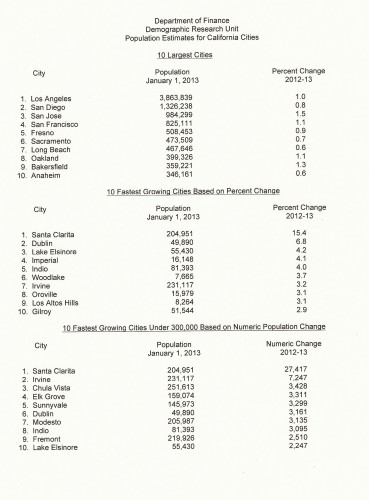Slight Population Growth in 2012, Brown Administration Reports
SACRAMENTO— California’s population grew by almost 298,000 residents in 2012 to 37,966,000 as of January 1, 2013, according to a population report released today by the Department of Finance.
The report shows preliminary January 2013, as well as revised January 2012, population data for cities. Highlights include:
- The San Francisco Bay area leads the state as the fastest growing region. Four out of the five fastest growing counties are in the Bay area. Santa Clara County is the fastest growing county in the state at 1.6 percent. Alameda, San Mateo, and San Francisco counties all had growth rates over 1 percent.
- The City of Los Angeles, California’s largest city, has a population of 3,863,839. Los Angeles grew by almost 37,000 persons during 2012. San Diego, California’s second largest city, now has a population of 1,326,238 and added over 11,000 persons during the year. San Jose, California’s third largest city, now has a population of 984,299 and added over 14,000 persons during the year.
- The City of Santa Clarita in Los Angeles County ranked as the fastest growing city in California, increasing by 15.4 percent. The bulk of the growth in Santa Clarita resulted from several annexations.
- The next four fastest growing cities were Dublin in Alameda County, 6.8 percent; Lake Elsinore in Riverside County, 4.2 percent; Imperial in Imperial County, 4.1 percent; and Indio in Riverside County at 4 percent. Dublin and Imperial added a proportionally large number of residents from recent housing increases. Lake Elsinore and Indio added a large number of housing units and also had considerable growth from annexation activity.
- The biggest numeric increases occurred in the state’s largest cities: Los Angeles (36,667), San Jose (14,423), San Diego (11,065), San Francisco (8,800). Santa Clarita 27, 417) was an exception because of the aforementioned annexation activity.
- The 2013 report lists 482 California cities, of which 444 had gains in population, 37 lost population, and one (Amador) experienced no change.
Other highlights include:
While still at historically low levels, California’s statewide housing growth was up 27 percent over the prior year, adding 45,309 housing units compared to the 2011 net increase of 35,638 units.
For the first time, multiple-family housing units surpassed single-family homes in new construction throughout the state. In 2012, local jurisdictions reported 23,801 multiple-family housing units and only 20,883 single-family homes statewide. In addition, 625 mobile homes were added.
Group quarters, such as college dorms, prisons and military barracks, comprise only slightly more than 2 percent of California’s population. Last year, group quarters declined by 1.2 percent statewide led by the continued reduction in state prison populations.
Prison declines caused some smaller cities, such as Calipatria in Imperial County and Ione in Amador County to experience large proportional population losses in 2012. Other cities, such as Folsom in Sacramento County that typically add population, saw a population decline last year due to a loss of group quarters population. Federal prison population remained steady, while college dormitory population showed an increase.
Background Information:
These population estimates are produced annually by the Department of Finance for use by local areas to calculate their annual appropriations limit. The State Controller’s Office uses these estimates to update their population figures for distribution of state subventions to cities and counties and to comply with various state codes. Additionally, estimates are used for research and planning purposes by federal, state and local agencies, the academic community and the private sector.
-30-
Filed under: Demographics
Capitol Cliches Conversational Currency Great Moments in Capitol History News Budget and Economy California History Demographics Fundraising Governor Legislature/Legislation Politics State Agencies
Opinionation Overheard Today's Latin Lesson
Restaurant Raconteur Spotlight Trip to Tokyo Venting Warren Buffett Welcome Words That Aren't Heard in Committee Enough


No comments yet.
RSS feed for comments on this post.